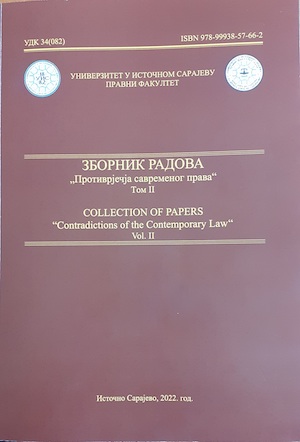Режим одговорности за повреду жигом заштићене ознаке на интернету у америчком, европском и међународном праву
Liability Regime for Trademark Infringement on the Internet in American, European and International Law
Author(s): Jelena Ćeranić Perišić
Subject(s): Law, Constitution, Jurisprudence, International Law, ICT Information and Communications Technologies
Published by: Правни факултет Универзитета у Источном Сарајеву
Keywords: Trademark; Liability; Internet; Infringement; Internet intermediaries;
Summary/Abstract: The Internet, global computer network that enables communication among users around the world, is defined by technical and technological capabilities that are balanced globally. In such an environment, different and even more imprecise regulations, which allow for uneven interpretations, contribute to legal uncertainty. The primary common interest of all participant in interactive communication is to establish normative framework for the harmonization of regulations at the global level. A comparative law analysis of the regime of liability of internet intermediaries for trademark infringement indicates the absence of harmonization of national and international approaches to the secondary liability of online service providers. There is a clear Atlantic division, more precisely the difference between the approach adopted by the courts of the United States of America and the approach adopted by European courts. In addition, the case law of the Member States is not uniform within the European Union itself. The lack of harmonization in this area has not been eliminated by international law, understood in terms of international legally binding sources (so-called soft international law). At this moment, only the so-called soft international law offers certain, very effective solutions in terms of harmonizing the regimes of liability of internet intermediaries for trademark infringement.Notice and Takedown System has for years, worldwide allowed Intellectual Property rights holders whose rights have been violated to notify the internet intermediaries and require them to remove content from the Internet. In line with this approach, most hosting providers have implemented internal Notice and Takedown Systems. Although the functioning of Notice and Takedown Systems operates in a similar way in international practice, there is a small, but significant difference between United States law and European Union law regarding the position of the internet intermediaries after receiving notification of an infringement. In EU law, if an internet intermediary does not necessarily imply its liability, but only that it will not automatically enjoy the immunity ("save harbors" regime). Moreover, an internet service provider to be held liable, the secondary liability standard must also be met based on the national law applicable in the particular case. On the contrary, according to US case law (established in case Tiffany Inc. v. eBay Inc.), if an internet intermediary, after being notified that his user is infringing someone else's trademark right, continues to provide services to him, this automatically withdraws its liability. despite the territorial fragmentation of the regime of liability of internet intermediaries, comparative legal research indicates that no legal system manages to provide an adequate response to the needs of the subjects, participants in interactive communications. Therefore, it is evident that there is a need to reform the regimes of liability of internet intermediaries for trademark infringement at national and international levels.
Book: Зборник радова "Противрјечја савременог права" Том II
- Page Range: 109-128
- Page Count: 20
- Publication Year: 2022
- Language: Serbian
- Content File-PDF

